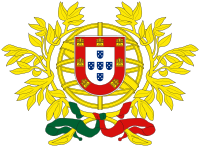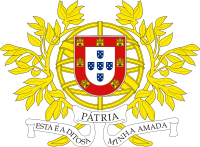Coat of arms of Portugal
| Coat of arms of Portugal | |
|---|---|
 |
|
| Versions | |

Version without laurel branches, for use on the National Flag, naval jack and some governmental flags
|
|

Version with the motto, for use on the national colors of the military units
|
|
| Details | |
| Armiger | Portuguese Republic |
| Adopted | 30 June 1911 |
| Escutcheon | Argent, five escutcheons in cross azure each charged with as many plates in saltire, all within a bordure gules charged with seven golden triple-towered castles |
| Motto | Esta é a ditosa Pátria minha amada |
| Other elements | Behind the shield, an armillary sphere between two olive branches embowed Or bound together in base by a ribbon vert and gules. |
The coat of arms of Portugal is the main heraldic insignia of Portugal. The present model was officially adopted on 30 June 1911, along with the present model of the Flag of Portugal. It is based on the coat of arms used by the Portuguese Kingdom since the Middle Ages. The coat of arms of Portugal is popularly referred as the Five Quinas or simply the Quinas (quinas being the five escutcheons of the Portuguese shield).
The national heraldry of Portugal evolved from the royal heraldry, with the royal coat of arms gradually coming to be considered a national coat of arms.
The Portuguese coat of arms itself is the result of almost a millennium of modifications and alterations. Starting with the cross azur on field argent, which constituted the putative shield of Henry, Count of Portugal in the 12th century, successive elements were added or taken, culminating with the complex heraldic design that was officially adopted in 1911 (after the Republican Revolution of 1910).
The main and constant element of the coat of arms of Portugal is and has always been the Portuguese shield. This resulted from around 300 years of evolution, from the 12th to the 15th centuries.
The putative initial shield used by Afonso Henriques, who became the first King of Portugal, was apparently the same as the one used by his father, Count Henry, being so a field argent with a cross azur.
The initial shield evolved to a field argent with five escutcheons azur forming a cross, the dexter and sinister ones pointing to the center, with each escutcheon semée of plates. This is the first confirmed model of Portuguese shield in use. Apparently, it was introduced still in the reign of Afonso Henriques (Afonso I) and definitely was used in the reign of Portugal's following King Sancho I (1185-1211). There are several legends that explain the origin of the five escutcheons and of the plates. The escutcheons are said that they represent either the five wounds of Christ in the Cross, the five wounds suffered by Afonso Henriques in the Battle of Ourique or the five moor kings defeated by him in this same battle. Regarding the plates, it is said that either they represent the pieces of silver received by Judas Iscariot to betray Jesus or the sovereignty of the Portuguese Kings symbolized by the right to issue their own money. A more mundane theory explains the origin of this shield in the original material shield of Afonso Henriques, which included a cross made by two blue leather bands nailed to a white field and which, after being successively hit in battle, had these bands ripped off, except the five pieces more close to the clusters of nails. These five pieces of blue leather and the heads of the nails, being so allegedly the origin of the five escutcheons azur, each semée of plates.
...
Wikipedia
